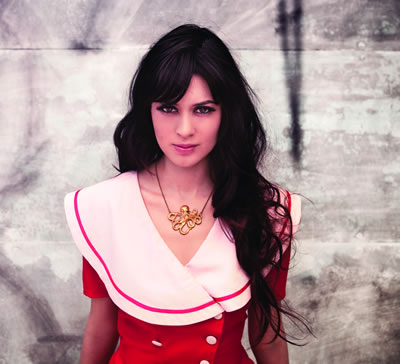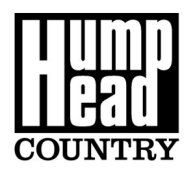Emilie Simon

Emilie Simon News
New to Wrasse Records, Emilie Simon's new album, 'The Big Machine'
Emilie Simon Links
Emilie Simon Albums
Emilie Simon Biography
It’s in New York, birthplace of all artistic hybrids, that Emilie Simon now lives, meaning that it’s in the heart of the Big Apple that the seeds of The Big Machine were planted and grown. The Big Machine: an impressive third album from a young French woman with a new freedom of expression, singing (almost exclusively) in English and continuing an expanded version of the musical adventure she started in 2003.
“After releasing records back to back, and a lot of non-stop touring, I felt I needed a break. Above all I wanted to experience some things for myself and not necessarily think about music. I upped and left with no microphone, no piano. I even forbade myself to go near a computer for a year and a half. I wanted to see what I was capable of without my usual comforts around me.”
Of course this imposed diet could only last a certain time, and soon Emilie tentatively started touching her instruments again, although with a different attitude to composing and singing, letting her intuition guide her as she has always done. She recorded her feelings day by day, approaching songs not as something magical, detached from the real world, but as a veritable sketchbook for the sensorial overload that is life in New York.
The Big Machine had been set in motion, and even if Emilie wasn’t aware of it at the time, distant ancestors of the New York music pantheon were being integrated into her plans, such as Laurie Anderson’s Big Science which itself reconciled thirty years of joyous and serious experimentation (O Superman), both avant-garde and pop. The first two Emilie Simon albums were already built around the perfect equilibrium that is somewhere between sensual songwriting and complex old-school electronics. This time – surprisingly, for someone who had never really tried working within a group – she started looking for musicians capable of bringing to life what she had in her head. And before that, as if to familiarise herself with the swooping emotions that numerous American musicians on the folk circuit had felt before her, she gave some solo concerts in a few clubs.
“I started playing the new tracks at the Roxy in Los Angeles. Then I had a residency in New York for five weeks, during which I forced myself each night to sing a new song that I'd just composed. The buzz grew so much that towards the end of the run some people couldn't get in because there was no more room.”
This served as encouragement to carry on with the imperial march of an album that was practically conceived live, an album that already had a firm structure when the other musicians were invited to enter into the fray.
“I wanted the album to be the transcription of the impression I had of New York, with both a black and white musical feel to it, urban, heavy on bass and drums and with explosions of colour and light from the synths.”
Sound engineer Mark Plati (David Bowie, Alain Bashung) soon appeared to be the best painter for such a décor, and several musicians hired after various chance meetings were incorporated into the project in order to bring the specific shades that Emilie wanted. For example, Kelly Pratt and John Natchez (Arcade Fire, Beirut) orchestrated the brass section for the opening track, Rainbow, sounding like a dark fanfare that energises the minimalist synths and contrasts with the already phosphorescent vocals, illuminating them even more. Incidentally, totally freed vocals underpin most of the songs on The Big Machine, whereas on her previous albums Emilie approached them rather as something weaved into what was already a dense electronic jungle. For her new songs, she wanted to give herself more space to try out something more daring and varied, showcasing - but not over-exposing - her crisp-toned voice whilst still keeping a foot in more carnal, romantic waters (Nothing To Do With You, The Devil At My Door), giving a knowing wink to the songwriting of Kate Bush and David Bowie in passing.
The other prominent element is the clever use of traditional Chinese instruments together with keyboards, a vestige of her long stay in the heart of Chinatown, an area which also gives its name to one of the songs on the album and spreads its influence over several tracks. It's especially noticeable on the irresistible hook of the first (aptly named) single, Dreamland. Before arriving in New York however, Emilie had headed for Montreal, and she returned there later to record some keyboards, a children's choir and drums with Jeremy Gara (Arcade Fire) - meeting up with sound engineer François Chevallier again on the way (they'd worked together several times before: on the Végétal album, the famous original score for March of the Penguins and the live show at Paris' prestigious Olympia venue). Along the way, Emilie worked on a few texts with English writer Graham Joyce (whom she met at the Gerardmer Film Festival) and finished off her long voyage in Paris together with Renaud Létang (Feist, Gonzalez…) to mix the album and give it as rough a feel as possible, less fussy than her previous albums.
The breathtaking result is surprisingly rich, and confirms Emilie Simon's multiple talents, proving definitively that she's not just good for tinkering with machines. Quite the contrary in fact: you'll find her venturing into unknown territories here, such as on the seductive track The Cycle with its hints of pop radio from the 70s/80s, or - at the other end of the spectrum - the astonishing Rocket To The Moon (co-written with Teitur) where she transforms into a sultry cabaret singer off Broadway. Both inventive and charming, as she always is, The Big Machine is also Emilie Simon's most accessible, personal record to date. A large part of it was recorded in the mythical Electric Lady studios, a fitting nickname for the lady herself.




